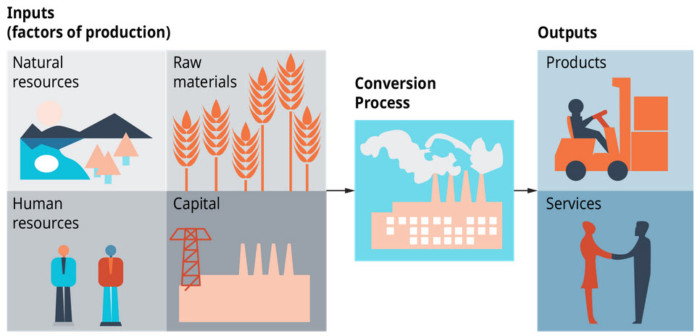Leaders must have expertise in planning, operations, finances, and strategy to drive business results. These four areas are known as the executive skill suite. Operations involve different departments working together to make high-quality products or services. Leaders who understand operations know how to keep their teams working well and making money throughout production. The most important thing about operational insight is that it lets leaders make realistic action plans and help them reach long-term strategic goals. In the end, knowing how operations work helps leaders direct the work of their departments toward the vision.
This article outlines the purpose of operations and how this knowledge can impact your leadership effectiveness. Further, the various departments involved and the operations management process is also described.
What is Operations?
Operations are the day-to-day activities that ensure the business achieves its goals, brings in revenue, and runs efficiently.


Every business sells products or services to customers. For instance, grocery stores sell various products while law firms sell their services to customers. Operations work to create a product or service that will generate revenue and, in turn, increase the business’s value over time. High-quality offerings attract customers and strengthen your market position. Operations must continually change to meet the needs of customers to increase sales, cover costs, and make a profit for shareholders.
Jim is the facilities operations manager at Tesla. He ensures things run smoothly by making key performance indicators showing how the team is meeting its production goals. Jim must also align everyone as a team and works with different departments to meet production deadlines. Jim’s job is to guarantee that customers get Tesla products quickly and efficiently.
Having efficient business operations gives you an edge over other businesses. For example, employees can improve their productivity by specializing in certain tasks, which can help them do their jobs better. Jim knows that the tasks in his department are challenging, so he only hires technicians with specific skills. This process assures each employee has the basic skills they need to become an expert at their job. This improves efficiency and reduces production delays caused by poor quality work.
Similarly, your operations also contribute to creating your distinct value proposition. For example, Tesla advertises itself as “a greener solution that adds high performance, design, functionality, efficiency, long-range, flexible, and low-cost (or free) recharging.” This empowers your business to deliver on the value and quality promised to its customers, investors, and other stakeholders.
Leaders must know the steps, tools, people, and systems for efficient operations. They work to optimize procedures, keep costs low, and meet customer expectations to bring in revenue and sustain operational efficiency. The departments responsible for operational activities include: sales, marketing, finance, and human resources.


Sales
Without salespeople, finding new customers and generating revenue for the business would be nearly impossible. The sales department acts as a connection between your customers and your brand. Their activities include contacting customers, making sales, keeping existing customers, and growing the business. Sales are the driving force behind revenue and growth, and these day-to-day activities help to achieve the mission and vision.
Unlike most car companies, Tesla doesn’t sell their cars through dealerships. Instead, they sell to their customers directly. You can view their selection of electric vehicles in person or online. Once you’ve decided on a model, associates will direct you to Tesla’s website to complete your purchase. Their sales approach cuts out the middleman and is more convenient for customers.
Marketing
Your business success depends on how well your marketing team creates and maintains a positive brand image for customers. Marketing defines what your business represents and serves as the face of your brand. The marketing team is responsible for campaign marketing activities, content creation, and social media management. Marketing builds your fanbase, which generates sales.
Tesla uses word-of-mouth marketing, which is a highly successful strategy. A referral program rewards existing customers who share their positive Tesla experiences with others.


Finance
Employees who are experts at converting numbers into business insight are crucial for increasing earnings. The finance department acts as a personal bookkeeper working behind the scenes to ensure the business runs efficiently. Finance activities include accounting, financial statement maintenance, budget forecasting, and operational system management. Interestingly, some businesses use financial analysts to conduct economic analyses to improve strategic planning.
Human Resources
It’s crucial to uphold your business culture and values to attract candidates who will work well with others. Human resources (HR) work to build a strong talent pipeline, select candidates who fit the culture, provide competitive compensation, and offer thorough training. HR also works to maintain a culture of people-friendly guidance and support. The ultimate goal is to foster a supportive work environment that attracts and keeps talented employees.
Although these departments serve very different functions, they all contribute to the day-to-day operation of the business. Each department adds value and helps bring in and maintain revenue to fund operations. Because the business’s success depends on these tasks, leaders must keep a close eye on each department to ensure they perform at their best. It’s important to note that operations consist of two different roles: line and staff functions.
Line Roles
Operational leaders must ensure that the business is consistently profitable. Line roles are directly responsible for accomplishing important goals that bring in revenue. For example, Jim trains the engineers who design the products that Tesla sells to customers. These roles are central to operations and the long-term sustainability of the vision.
Staff Roles
The line roles need support to run efficiently. Staff roles enable line roles to do their best work and add customer value. Jim has engineers who occasionally need more product development training. He contacts HR to train several engineers as soon as possible to meet operational deadlines.
The ultimate goal of line and staff roles is to produce products or services efficiently. Since manufacturing is complex, leaders must have a process that helps coordinate activities.
Operations Management
Leaders are responsible for planning, organizing, controlling, and coordinating the production of products and services. Operations management is a process that manages the transformation process of raw materials, natural and human resources, or capital into high-quality products or services. For example, Tesla’s production process transforms raw materials like cobalt, aluminum, and nickel into the Model S electric car. The manufacturing process consists of four parts: materials planning, process planning, capital requirements, and human capital.


Materials Planning
Operation leaders must list all the materials needed for the manufacturing process. Once the list is created, leaders will coordinate the purchasing and delivery of the materials for the process planning phase.
Process Planning
Leaders must figure out each step to make the product quickly, well, and with as little waste as possible.
Capital Requirements
The phase of operations management deals with buildings and machinery. When leaders plan for materials, they must ensure that the process can use or accept all of the materials and that there is enough equipment to process them.
Human Capital
Managing employees helps the manufacturing process run smoothly so that high-quality goods are made and sent to customers as quickly as possible.
Operations management’s ultimate goal is to increase efficiency, maximize productivity, make money while cutting costs, and deliver products and services that meet customers’ needs.


Operations Management System
An operations management system (OMS) is a collection of processes that make operations simpler, cheaper, easier to work on across departments, and more productive. If you want to add structure to your operations, consider this four-stage process: initial gap assessment and planning, management system design, implementation, and improvement and sustainment.
Initial Gap Assessment
Leaders must agree on a vision during the beginning of OMS implementation. For instance, the vision for Jim’s department is to manufacture high-quality products as quickly as efficiently while always looking to cut costs whenever possible. Once a vision is in place, departmental leaders must have a common understanding of the project, agree on the approach, and communicate this information to the teams. Then an initial gap assessment must consider how the new OMS will fit within existing systems and programs to minimize change where possible. The goal is to identify and work on high-priority improvements in parallel with the rest of the implementation.
Management System Design
At the start of implementing the OMS, leaders must agree on a vision. For example, Jim’s vision for his department is to make high-quality products as quickly and efficiently as possible while always looking for ways to save money. Once a vision is agreed upon, departmental leaders must have a shared understanding of the project, agree on how to do it, and communicate with their teams. Then, an initial gap assessment determines how the new OMS will fit in with existing systems and programs to keep change to a minimum. The goal is to find high-priority improvements and work on them simultaneously as the rest of the implementation.
Management System Implementation
The OMS implementation includes a set of planned tasks, such as communicating with and training employees. It’s essential to tell the people involved what to expect if you want them to help with the implementation. Also, the proper training makes sure that employees do their jobs and know how to align their activities with the OMS. Lastly, operational gap analyses ensure that high-priority information is written down so leaders can make changes if needed.
Improvement and Sustainment
Action planning and prioritization translate gaps into action plans delegated to different teams to manage. Leaders also make key performance indicators (KPIs) and metrics to track the progress of implementation toward the desired future state. Once the OMS is in place, leaders need to set up an annual management review to see if the OMS is doing what they want it to do.


Conclusion
Leaders that have operational knowledge know how to translate strategic goals into daily action by generating revenue to maximize profitability and shareholder returns. They achieve this by managing various departments throughout the manufacturing process to produce high-quality products to meet customer needs. The operational departments include sales, marketing, finance, and human resources. These departments make up either line or staff functions. Operations management help leaders monitor the manufacturing process, which involves materials and process planning, capital requirements, and human capital. An OMS ensures efficient processes that help minimize complexity, reduce cost, and enforce cross-departmental collaboration. Operational knowledge helps leaders think strategically, meaningfully contributing to their business’s growth and profitability.
Bianca Cardenas, M.S., Ph.D., is a Fellow in Executive Assessment and Consulting with Leadership Worth Following. Dr. Bianca Cardenas empowers leaders to transcend competition by helping them unlock their people's potential.







Hi there, You have done an excellent job. I will definitely digg it and personally recommend to my friends. I’m confident they’ll be benefited from this site.